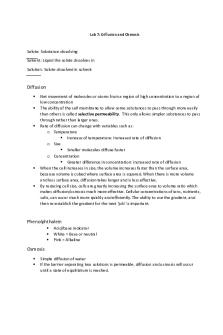Osmosis and diffusion PDF

| Title | Osmosis and diffusion |
|---|---|
| Course | Biology 2 |
| Institution | University of North Carolina at Charlotte |
| Pages | 2 |
| File Size | 555.7 KB |
| File Type | |
| Total Downloads | 11 |
| Total Views | 159 |
Summary
osmosis and diffusion...
Description
Name: ____________________________________________ Date: ___________ Period: ________
Osmosis & Diffusion Worksheet: 1. Y or N: Is water always able to diffuse through a cell’s selective permeable membrane? 2. Y or N: Are solutes always able to diffuse through a cell’s selective permeable membrane? 3. The movement of molecules across a cell membrane against its concentration gradient is called
_________________ ___________________. Below are animal cells placed in beakers of various concentrations For each beaker: A. Draw an arrow to show which way the water would move by osmosis. D. Draw and label what would happen to the cell as a result of diffusion/osmosis (shrivel, swell). E. Name the type of solution (hypertonic, isotonic, hypotonic). F. If there are any missing percentages, fill them in.
For cells 10-18, the particle size of the solute is not able to diffuse through the semi-permeable membrane.
hyper 1.
90
hypo 2.
60
hyper 3.
25
shrivel 80
4.
57
70
6.
5.
40
90
90 20
7.
85
8.
61
9.
10
80 20
65
Matching a. away b. diffusion c. solute
d. low e. molecules f. permeable
g. high h. osmosis i. towards
j. hypertonic k. vacuole l. semi-permeable
m. hypotonic n. water o. concentration gradient
1. The cell membrane regulates and controls what kind of ____ move in & out of the cell. 2. When molecules spread from an area of high to low concentration to, it is called ____. 3. As molecules diffuse, they create a ____, which is a difference in concentrations across space. 4. Cell membranes are ____. This means that they only allow certain things to pass through. 5. A membrane that would allow ANYTHING to pass through it would be called ____. 6. Diffusion is the movement of molecules. Osmosis is the diffusion of ____ 7. ____ is the process of water molecules moving across a cell membrane. 8. The direction that water molecules move is determined by the difference in the concentration of ____ dissolved in the solvent inside and outside the cell. 9. Osmotic pressure, or osmosis, pushes water molecules ____ the area of greater solute concentration. 10. Water molecules are pulled ____ from areas of lower solute concentration. 11. The word hypertonic means ____ concentration of solutes. 12. The word hypotonic means ____ concentration of solutes. 13. A plant cell undergoes plasmolysis, or shrinking of the cell membrane, when it is placed in a solution with a HIGH concentration of solute. What type of solution causes plasmolysis? ____. 14. An animal cell undergoes cytolysis, or stretching of the cell membrane, when it is placed in a solution with a very LOW concentration of solute. What type of solution causes cytolysis? ____ 15. Turgor pressure is the flow of water into a plant cell that causes the cell membrane to be pushed up against the cell wall and causes the sac in a plant cell to expand. What is this sac that holds this water from the turgor pressure? ____
16. ___ In the picture to the right, the movement of water across the membrane will be (A) mostly out (B) mostly in (C) in and out equally
10% salt
17. ___ In the picture to the right, the movement of water across the membrane will be (A) mostly out (B) mostly in (C) in and out equally 2% salt 18. ____ In the picture to the right, the movement of water across the membrane will be (A) mostly out (B) mostly in (C) in and out equally 30% salt
10% salt
10% salt
10% salt...
Similar Free PDFs

Diffusion and Osmosis lab
- 3 Pages

Diffusion and Osmosis Worksheet
- 2 Pages

210 diffusion and osmosis
- 5 Pages

Osmosis and diffusion
- 2 Pages

Diffusion and osmosis lab
- 4 Pages

Osmosis and diffusion
- 11 Pages

Diffusion and Osmosis lab
- 4 Pages

Lab 4 - Diffusion and Osmosis
- 6 Pages

Lab 4 Diffusion and Osmosis
- 7 Pages

Lab 7: Diffusion and Osmosis
- 2 Pages

Lab 5 Diffusion and Osmosis
- 1 Pages

Diffusion and osmosis lab 1
- 4 Pages

Diffusion and Osmosis Lab Report
- 8 Pages
Popular Institutions
- Tinajero National High School - Annex
- Politeknik Caltex Riau
- Yokohama City University
- SGT University
- University of Al-Qadisiyah
- Divine Word College of Vigan
- Techniek College Rotterdam
- Universidade de Santiago
- Universiti Teknologi MARA Cawangan Johor Kampus Pasir Gudang
- Poltekkes Kemenkes Yogyakarta
- Baguio City National High School
- Colegio san marcos
- preparatoria uno
- Centro de Bachillerato Tecnológico Industrial y de Servicios No. 107
- Dalian Maritime University
- Quang Trung Secondary School
- Colegio Tecnológico en Informática
- Corporación Regional de Educación Superior
- Grupo CEDVA
- Dar Al Uloom University
- Centro de Estudios Preuniversitarios de la Universidad Nacional de Ingeniería
- 上智大学
- Aakash International School, Nuna Majara
- San Felipe Neri Catholic School
- Kang Chiao International School - New Taipei City
- Misamis Occidental National High School
- Institución Educativa Escuela Normal Juan Ladrilleros
- Kolehiyo ng Pantukan
- Batanes State College
- Instituto Continental
- Sekolah Menengah Kejuruan Kesehatan Kaltara (Tarakan)
- Colegio de La Inmaculada Concepcion - Cebu


